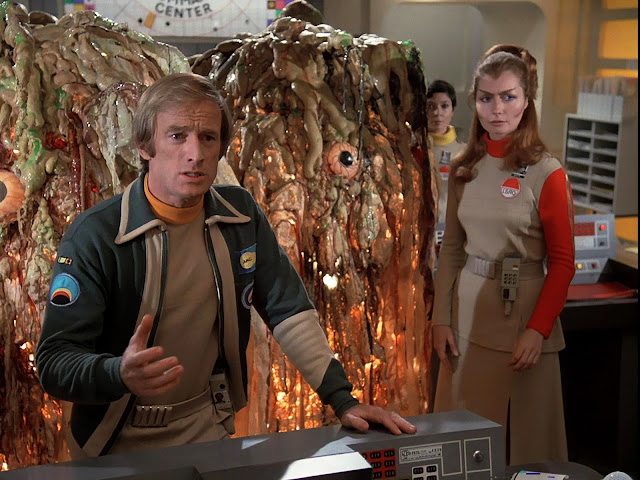SPACE: 1999 – 2.
Romance! Laughs! Monsters! … New producer Fred Freiberger’s action series revisioinism of Space: 1999 takes some getting used to after the 1975-76 series’ serious mood. Scenes of domesticity and ‘humour’ – such as Dr Russell (Barbara Bain) and new addition, alien shapeshifter Maya (Catherine Schell), trying on new frocks, together with the home brew disasters of Tony Verdeschi (Tony Anholt) – were presumably inserted to give the Alphans a life outside their duties. Sadly, with a few exceptions these sequences are forced and not very funny.
The ‘family entertainment’ directive also extends to putting the Alphan men in trousers and all the Alphan women in skirts. Elsewhere, Maya becomes Moonbase Alpha’s science officer, a post held on the USSS Enterprise by the half-Vulcan, half-human Mr Spock (Leonard Nimoy). In short, the new model for Space: 1999 is Star Trek (1966-69); perhaps not surprisingly, as Freiberger produced the series at the end of the 1960s. Dr Russell even has a ‘Captain’s Log’-style voiceover at the top of every episode.
The Star Trek parallels keep coming. ‘New Adam New Eve’ revolves around an apparently immortal being called Magus (Guy Rolfe), while Trek’s ‘Who Mourns for Adonais?’ (1967) had the Enterprise crew confronting a being who claimed to be the Greek god Apollo. Significantly, both stories share similar scenes of the crew confronting a ‘god’ in space, being confined to a garden paradise and discovering that their immortal’s power source is technological. Both ‘The Rules of Luton’ and Trek’s ‘The Gamesters of Triskelion’ (1967) feature duels with aliens “in the crucible of combat.”
In year two, the Moonbase command centre set shrank in size, inadvertently reflecting the series’ shrinking creative horizons. Stories in the first season such as ‘Another Time, Another Place’, ‘Missing Link’ and ‘Full Circle’ examined the concept of identity and altered states of mind; in year two, the stories became increasingly pulp SF and/or silly. ‘The Taybor’ is truly awful: dull and inconsequential, its only point of interest is that it looks like the roguish space trader was being established as Space 1999’s equivalent of Harcourt Fenton Mudd, a similar character in – you guessed it – Star Trek. ‘Seed of Destruction’ runs with the old-as-the-hills pulp SF trope of the evil double, its saving grace being Martin Landau’s frightening portrayal of the bullying, duplicate Koenig.
Very little happens in ‘The Beta Cloud’, apart from Tony chasing a robot disguised as a monster around Alpha’s corridors. This had obviously occurred to the director too, because the usually restrained incidental music takes a bizarre turn into a frenzied jazz-funk workout. It really does sound like the composer is trying to distract the viewer from the leaden pacing of on-screen events.
‘Brian the Brain’ (above), by playwright Jack Ronder, is a complete contrast. Cast very much against type, Bernard Cribbins provides the voice of a mobile computer with an Oedipus complex – it murdered its inventor because he was going to replace it with a newer model. Increasingly unstable, the computer tricks the Alphans into giving it fuel cells crucial to the moon colony’s survival. The ending is psychologically clever, as well as an inventive use of Maya’s metamorphic abilities.
Another stand out is former Doctor Who script editor Terrance Dicks’ ‘The Lamda Factor’. A space phenomenon is stimulating the psi abilities of people on Alpha, causing Koening to be tormented by visions of crew members he abandoned to plague on Venus. He can’t sleep and fears a complete mental breakdown. At the same time, the death of an Alphan goes unexplained and the base’s systems are breaking down. Dicks gives Landau some substantial, rewarding material to work with, focusing on character rather than action, so it’s not surprising that it’s his best performance of the second series. If only there’d been more imaginative stories like this and ‘Brian the Brain’.
Disappointingly, there are increasingly comic strip sci-fi costume and make up choices – John Standing, guest star in ‘The Mark of Archanon’, looks especially uncomfortable in a tight-fitting corset and bare legs – suggesting that Freiberger wasn’t interested in Space 1999’s intellectual and philosophical aspirations. The trouble is, he didn’t have anything to replace them with, beyond a paper-thin imitation of Star Trek’s format.
For all that, in its second year Space: 1999 remains largely entertaining, if sometimes for the wrong reasons.




Comments
Post a Comment